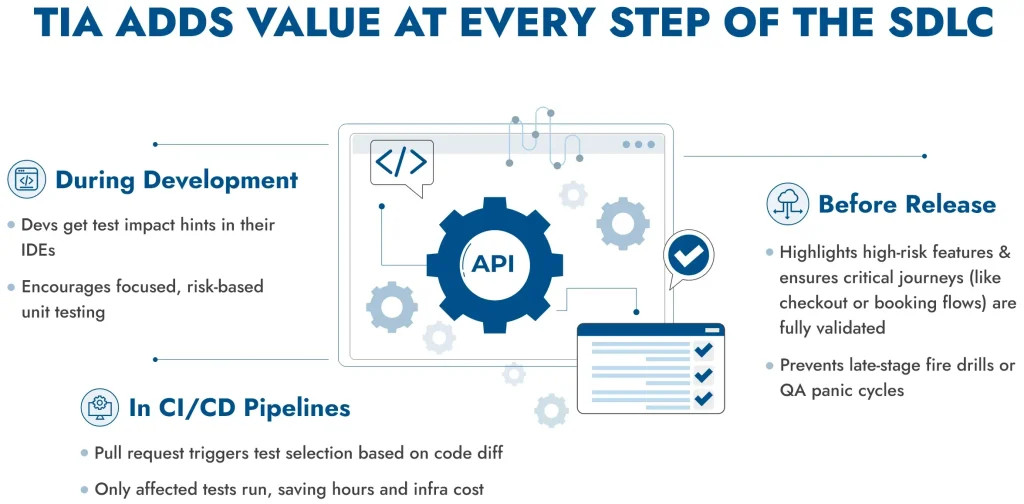You don’t have to wait for a PR merge to use TIA.
TIA adds value at every step of the SDLC—not just inside your CI/CD pipeline, but well before and after that too. Here’s how:

Impact Visibility While Coding: TIA tools plug into your IDE and flag potential downstream effects of even minor code changes—right as you're writing them. This helps developers catch issues before they ever reach staging.
Smarter Test-Driven Development: Practicing TDD? TIA highlights the parts of your code most prone to regressions based on past changes—so you can focus unit tests where it matters most.

CI/CD Pipeline Optimization: Once a pull request is created, TIA evaluates the exact blast radius of the change and selects only the relevant tests for execution. No wasted runs.
Microservice Mapping: In complex travel platforms with 20+ interconnected services, TIA automatically identifies affected services and orchestrates smart test execution specifically for those.

Regression Without the Bloat: Instead of running thousands of regression tests, QA teams execute only what’s needed. The result? Better focus and faster test cycles.
Final Validation, Prioritized by Risk: Before shipping, TIA ensures the most business-critical flows—like booking confirmations, payments, or cancellations—are tested first, based on historical risk.

Scaling a travel tech platform isn’t just about adding more destinations or partnerships—it’s about releasing features faster while maintaining reliability. This means your delivery process must evolve. Relying on full-scope regression for every minor change slows innovation.
TIA solves this by injecting intelligence into every CI/CD run. Integrated into platforms like Azure DevOps, TIA analyzes each pull request in real time, identifies affected areas, and executes only what’s needed. It auto-skips unaffected tests, visualizes risk across modules, and alerts developers instantly when regressions are detected in high-impact areas.
When paired with test automation frameworks and containerized runners, this process becomes fully elastic. Test jobs can scale dynamically, execute across distributed environments, and feed results into dashboards within minutes.
One of the most common concerns about faster releases is: "What if we miss something?" It’s a valid fear—especially in travel tech, where dependencies are deep and unpredictable. But the solution isn’t more testing—it’s smarter testing.
TIA helps reduce test suite bloat caused by overly defensive QA strategies. Rather than maintaining bloated regressions with thousands of overlapping cases, teams use impact analysis to surgically select what needs validation.
Over time, your test suite becomes leaner, not weaker. It evolves with your product, guided by real code changes, business logic dependencies, and runtime insights. The result? Faster pipelines, lower cloud compute costs, and fewer false positives that delay releases.
Travel companies with distributed engineering teams and multiple release trains need a seamless CI/CD pipeline. When combined with service virtualization and container-based test runners, TIA gives QA teams startup-like agility at enterprise scale.
Azure DevOps Pipelines, integrated with TIA, automatically:
Most articles about TIA stop at the basics. They mention how it reduces test suite size or speeds up builds. Those are benefits—but they only scratch the surface.
If you’re leading a fast-paced engineering team or managing a complex travel platform, you need more than speed. You need confidence, clarity, and control over quality.
Here’s what modern Test Impact Analysis really offers:
Handles Microservices Like a Pro: In travel tech, a single booking flow might touch 12 microservices. TIA understands those connections and tests only the ones logically downstream from your code changes. It’s surgical precision for distributed systems.
Makes TDD and Peer Reviews Smarter: When developers get test impact visibility before they push, they naturally write better code. Peer reviewers can focus on business logic instead of arguing over test coverage gaps.
Works With Canary Releases and A/B Tests: Testing doesn’t have to be all-or-nothing. Whether you’re rolling out to 20% of users or testing two pricing strategies, TIA ensures only those experiences are validated. That means better targeting, lower costs, and faster iterations.
Better Reporting for Stakeholders: Your dashboard isn’t just red or green. TIA lets QA leads and engineering heads slice test coverage by feature, release, or team—keeping execs informed without drowning them in tech speak.
| Cookie | Duration | Description |
|---|---|---|
| __cf_bm | 1 hour | This cookie, set by Cloudflare, is used to support Cloudflare Bot Management. |
| _cfuvid | session | Calendly sets this cookie to track users across sessions to optimize user experience by maintaining session consistency and providing personalized services |
| cookielawinfo-checkbox-advertisement | 1 year | Set by the GDPR Cookie Consent plugin, this cookie records the user consent for the cookies in the "Advertisement" category. |
| cookielawinfo-checkbox-analytics | 11 months | This cookie is set by GDPR Cookie Consent plugin. The cookie is used to store the user consent for the cookies in the category "Analytics". |
| cookielawinfo-checkbox-functional | 11 months | The cookie is set by GDPR cookie consent to record the user consent for the cookies in the category "Functional". |
| cookielawinfo-checkbox-necessary | 11 months | This cookie is set by GDPR Cookie Consent plugin. The cookies is used to store the user consent for the cookies in the category "Necessary". |
| cookielawinfo-checkbox-others | 11 months | This cookie is set by GDPR Cookie Consent plugin. The cookie is used to store the user consent for the cookies in the category "Other. |
| cookielawinfo-checkbox-performance | 11 months | This cookie is set by GDPR Cookie Consent plugin. The cookie is used to store the user consent for the cookies in the category "Performance". |
| CookieLawInfoConsent | 1 year | CookieYes sets this cookie to record the default button state of the corresponding category and the status of CCPA. It works only in coordination with the primary cookie. |
| viewed_cookie_policy | 11 months | The cookie is set by the GDPR Cookie Consent plugin and is used to store whether or not user has consented to the use of cookies. It does not store any personal data. |
| wpEmojiSettingsSupports | session | WordPress sets this cookie when a user interacts with emojis on a WordPress site. It helps determine if the user's browser can display emojis properly. |
| Cookie | Duration | Description |
|---|---|---|
| li_gc | 6 months | Linkedin set this cookie for storing visitor's consent regarding using cookies for non-essential purposes. |
| lidc | 1 day | LinkedIn sets the lidc cookie to facilitate data center selection. |
| wp-wpml_current_language | session | WordPress multilingual plugin sets this cookie to store the current language/language settings. |
| yt-remote-cast-installed | session | The yt-remote-cast-installed cookie is used to store the user's video player preferences using embedded YouTube video. |
| yt-remote-connected-devices | never | YouTube sets this cookie to store the user's video preferences using embedded YouTube videos. |
| yt-remote-device-id | never | YouTube sets this cookie to store the user's video preferences using embedded YouTube videos. |
| yt-remote-fast-check-period | session | The yt-remote-fast-check-period cookie is used by YouTube to store the user's video player preferences for embedded YouTube videos. |
| yt-remote-session-app | session | The yt-remote-session-app cookie is used by YouTube to store user preferences and information about the interface of the embedded YouTube video player. |
| yt-remote-session-name | session | The yt-remote-session-name cookie is used by YouTube to store the user's video player preferences using embedded YouTube video. |
| ytidb::LAST_RESULT_ENTRY_KEY | never | The cookie ytidb::LAST_RESULT_ENTRY_KEY is used by YouTube to store the last search result entry that was clicked by the user. This information is used to improve the user experience by providing more relevant search results in the future. |
| Cookie | Duration | Description |
|---|---|---|
| _ga | 1 year 1 month 4 days | Google Analytics sets this cookie to calculate visitor, session and campaign data and track site usage for the site's analytics report. The cookie stores information anonymously and assigns a randomly generated number to recognise unique visitors. |
| _ga_* | 1 year 1 month 4 days | Google Analytics sets this cookie to store and count page views. |
| _gcl_au | 3 months | Google Tag Manager sets the cookie to experiment advertisement efficiency of websites using their services. |
| _li_id | 2 year | Leadinfo places two cookies that only provides Eastern Enterprise insights into the behaviour on the website. These cookies will not be shared with other parties. |
| Cookie | Duration | Description |
|---|---|---|
| bcookie | 1 year | LinkedIn sets this cookie from LinkedIn share buttons and ad tags to recognize browser IDs. |
| guest_id | 1 year 1 month | Twitter sets this cookie to identify and track the website visitor. It registers if a user is signed in to the Twitter platform and collects information about ad preferences. |
| test_cookie | 15 minutes | doubleclick.net sets this cookie to determine if the user's browser supports cookies. |
| VISITOR_INFO1_LIVE | 6 months | YouTube sets this cookie to measure bandwidth, determining whether the user gets the new or old player interface. |
| VISITOR_PRIVACY_METADATA | 6 months | YouTube sets this cookie to store the user's cookie consent state for the current domain. |
| YSC | session | Youtube sets this cookie to track the views of embedded videos on Youtube pages. |
| yt.innertube::nextId | never | YouTube sets this cookie to register a unique ID to store data on what videos from YouTube the user has seen. |
| yt.innertube::requests | never | YouTube sets this cookie to register a unique ID to store data on what videos from YouTube the user has seen. |
| Cookie | Duration | Description |
|---|---|---|
| __Secure-ROLLOUT_TOKEN | 6 months | Description is currently not available. |
